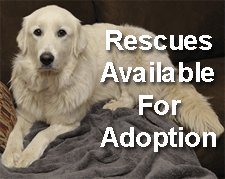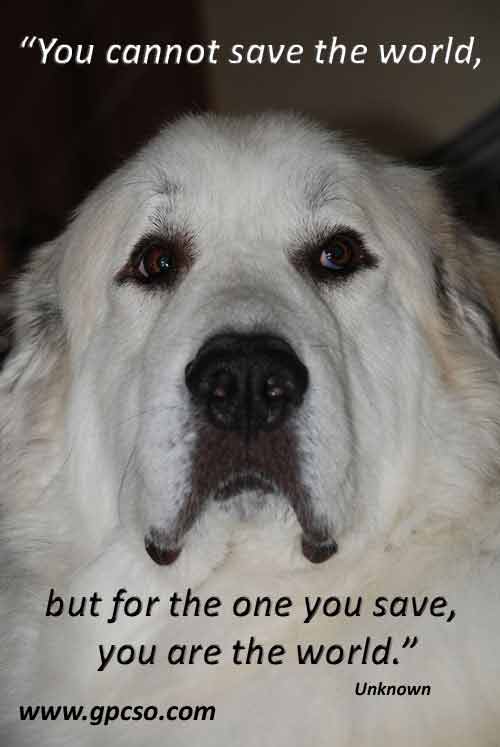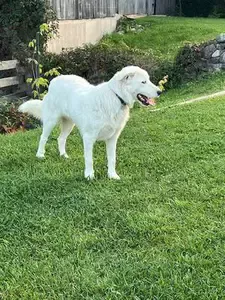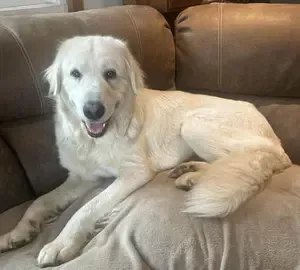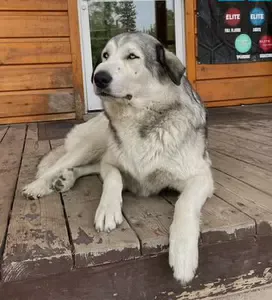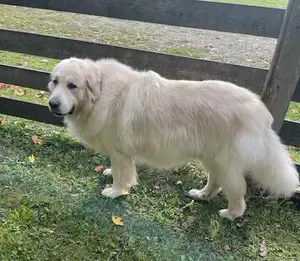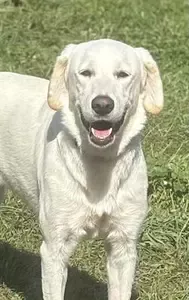Morgan
Sadly, Morgan was sick for a short time and passed away. He had a good few of years with Carol. He was such a goofball, and didn't have a mean bone in his body. Rest in peace big boy.
We are pleased to announce Morgan will be staying with us as a companion to twelve year old, Boo, who came to us in 2009.
Morgan is 10-years old.
He was removed from his home by Ontario SPCA along with another dog.
He is surprisingly strong for his age, gentle in nature and loves human interaction. He needs some basic training but seems quite responsive to positive direction. He deserves a patient, loving home to provide him with love and comfort in his twilight years.
Make sure to do your research on any breed in which you are interested. Please read the following:
They are lovely but not a breed for most people. They are great dogs when they come from ethical/reputable breeders, with the crucial socialization and handling by many many different people. They were developed by man to be working dogs. Here is a brief summary of the Pyr:
They are beautiful dogs with great temperaments given the right breeding, socialization, care including diet and training. Dogs are a lifelong commitment.
BARKING: They bark more than most dogs and neighbours do complain. That is a common reason for people surrendering their Pyrs (they didn’t do their research). Their bark is what deters predators and it is instinct to them. That and marking their territory. To take away their bark is to take away who they are. The barking can be managed but it takes time, patience and consistency with positive-reinforcement training. If you don’t like barking, they are not the dog for you.
CONTAINMENT: Pyrs love to hang out outside and their instinct is to wander. Therefore, they require at least a 5-foot secure fence in a large yard in which they can play, run and watch over. Some have been know to scale any height of fencing. No tie outs for these guys. It can lead to aggression since they cannot fully watch over their territory. If they are out all day, as they usually prefer, they need shelter from the elements. And, no electric collars or invisible fencing. If you do not want to fence, this is not the dog for you.
DIGGING: They dig holes in your garden to stay cool in summer so you’ll want to set aside some garden for them.
DIET: Raw is the species-appropriate diet. They eat 2%-3% of the ideal body weight. The breakdown is about 50% edible bone, 35% muscle meat and 5-10% organ meat of beef, chicken, rabbit, deer etc. Do not feed what they are guarding. Start them out on one protein until they are used to it and gradually add another. If you need to feed kibble, ensure it is of high quality and preferably the baked kind.
Raw food primer
DOGS: If you want more than one dog in the home or working, we always recommend two dogs of the opposite sex. Two males or two females do not always see eye-to-eye and fights will ensue in most cases, but not all.
EXERCISE: They require regular walks, of course, so they get out and see the world to keep them interested in life. They must be leashed because they will wander. Again, they have been specifically bred to wander with sheep as they watch over them. It’s suggested to use a front lead harness which will cut down on any damage to the spine should the dog pull although, with a little training, they will be good on a leash. If you don't want to get out there and hike/walk your dog, this is not the dog for you.
GROOMING: Working and companion dogs must be groomed. They require a good weekly grooming to keep them mat free and their skin healthy (hence, pain free from the pulling of mats as they move), and cutting their nails including their dew claws every couple of weeks to a month. NEVER have their dew claws removed. This is a barbaric practice. Simply keep the dews trimmed.
They molt twice a year and shed all year round so your vacuum stays full. NEVER shave a Pyr. Their coats keep them cool in summer. They lose their undercoat, leaving just guard hairs. The guard hairs protect your dog from sunburn and insulate him against heat, as well as allowing air to circulate to keep the skin cool in summer and warm in winter. Their undercoat grows close to the skin to keep your dog warm and dry. This system only works if you groom your dog regularly. If you don’t like grooming, take your dog to a master groomer. If you don’t want to groom your dog, this isn’t the dog for you.
TRAINING: They require a lot of socialization as pups onward with people and other dogs. They also require positive-reinforcement training (a trainer who shows you how to work with a clicker). Pyrs, nor any dogs, take kindly to any kind of punishment. Always use positive-reinforcement training. It will lead to aggression. Dr. Sophia Yin and Absolute Dogs are great website resources.
It’s important to work with dogs as if in a dance and you are leading. Rewards for good behaviour and redirect for unwanted behaviour. It’s up to you to make them a good canine citizen. When engaging a trainer, ensure they use positive-reinforcement training to show you how to manage your dog. Never send a dog away for training. You are the one working with the dog, not a trainer. If you are not ready to train a dog, this is not the dog for you.
To train a Pyr is not like training some other breeds. They are not eager-to-please and just as soon walk away from you than do as you say. They were bred by man to be used as guardian livestock dogs because they do not require human intervention to tell them how to do their job. Lots of patience, consistency and time is required to work with them. If you want an obedient dog, this is not the dog for you.
TRAINING FOR LIVESTOCK: There are a few who just want to be a companion dog. Most are natural guardian dogs of livestock. Yes, it is instinct. However, you must introduce your dog to any livestock slowly. This means leashing your dog to you as you work about the animals and barns so they get used to them. When you are not there, keep them safely away from the animals yet still in sight of them. Fowl can be difficult for dogs because of how they move but it can be done. It will take at least a month for a Pyr to get used to the animals, maybe less. You’ll know when they are ready, and the dog will take it from there.
WHY ARE THEY SURRENDERED: There are those in need of a home because someone didn’t realize they would get so big, bark so much (complaints from neighbours), leave so much hair in the house, wander, and require work. There are also those whom people want to surrender for aggression but we do not take those dogs in. These dogs usually come from farmers, backyard breeders and pet shops (puppy mills) where genetics are unknown by the ‘breeders’. Combine this with lack of socialization and handling by many many different people in the crucial first thirteen weeks of their lives, and by the time they start to mature, aggression can set in.
It is very important to do your research on any breed before deciding if they are a good match for your family. Please start here:
Great Pyrenees
Regarding dogs and children. We never want to set dogs up for failure so it’s important that children learn how to behave with dogs, and that parents never leave their children alone with a dog. Here is a link on that subject:
Best Dogs for Children
Breaking News
-
Courtesy Post - Sarge
Dec 30, 25 06:34 AM
Courtesy Post - Sarge Location: Mount Albert, Ontario DoB: Unknown 2023 Required: He is comfortable around livestock, but he will go as a companion -
Hardy
Dec 26, 25 06:23 PM
Hardy Location: Acton, ON DOB: Approx. January 2025 (we think he is older though) Single-family home required. Minimum 5-foot securely fenced yard. -
Bo
Dec 12, 25 02:22 PM
*ON HOLD* DOB: late Sept 2023 (don’t know for sure) rescued Dec 2023 Location: Acton, Ontario Name: Bo Single dwelling home with a securely fenced -
Ronnie
Nov 22, 25 06:20 AM
*Adopted* Location: Acton, ON DOB: 9-years-old This big sweetheart went to foster and was soon adopted before we got him posted. From the shelter: -
Lola
Nov 19, 25 12:01 PM
*ADOPTED* A single family dwelling and a securely fenced yard of at least 5 feet are musts. DOB approx: Februay 12, 2021 Location: Acton, Ontario This -
Mayne
Nov 07, 25 04:04 PM
*ADOPTED* (FOSTER FAIL) Mayne Location: Acton, ON DOB: August 5, 2017 (8-years-old) Single-family home required. Minimum 5-foot securely fenced yard. -
Courtesy Post - Remi
Oct 17, 25 11:09 AM
*ADOPTED* Remi (Retriever/Pyr cross) D.o.B: Sept. 30, 2023 Location: Between Owen Sound and Port Elgin (Tara, ON) Remi was given up because of health -
Courtesy Post - Virgil
Sep 30, 25 01:03 PM
*ADOPTED* DoB of Virgil: 2021 (4.5 years old) Reason for rehoming this big white fluffy: Owner has passed away and he is presently living in an apartment.




